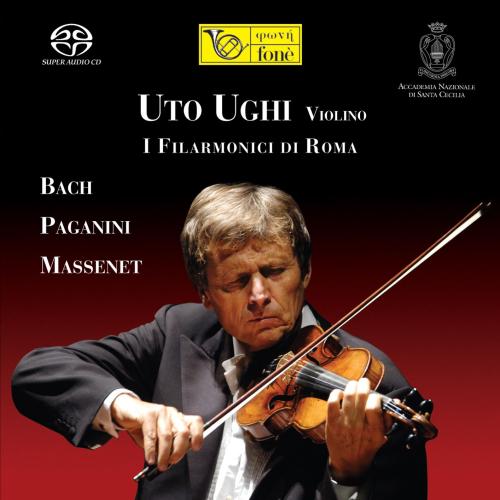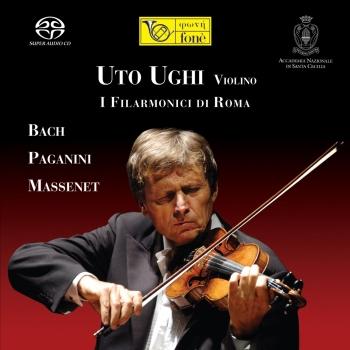
Bach, Paganini, Massenet Uto Ughi & I Filarmonici di Roma
Album Info
Album Veröffentlichung:
2004
HRA-Veröffentlichung:
07.05.2021
Label: fonè Records
Genre: Classical
Subgenre: Concertos
Interpret: Uto Ughi & I Filarmonici di Roma
Komponist: Johann Sebastian Bach (1685–1750), Nicolo Paganini (1782-1840), Jules Massenet (1842-1912), Johann Christian Bach (1735-1782)
Das Album enthält Albumcover Booklet (PDF)
- Johann Sebastian Bach (1685 - 1750): Concerto in La Min. No.1 per violino ed archi BWV 1041:
- 1 J. S. Bach: Concerto in La Min. No.1 per violino ed archi BWV 1041 - I Allegro non tanto 04:36
- 2 J. S. Bach: Concerto in La Min. No.1 per violino ed archi BWV 1041 - II Andante 06:37
- 3 J. S. Bach: Concerto in La Min. No.1 per violino ed archi BWV 1041 - III Allegro assai 04:37
- Niccolò Paganini (1782 - 1840): Concero in Re Min. No.4 per violino e orchestra:
- 4 N. Paganini: Concero in Re Min. No.4 per violino e orchestra - I Allegro maestoso 14:16
- 5 N. Paganini: Concero in Re Min. No.4 per violino e orchestra - II Adagio flebile 04:56
- 6 N. Paganini: Concero in Re Min. No.4 per violino e orchestra - III Rondò (andantino) 07:54
- Jules Massenet (1842 - 1912): Meditation da "Thais" per violino ed orchestra:
- 7 J. Massenet: Meditation da "Thais" per violino ed orchestra 05:14
- Johann Christian Bach (1735 - 1782):Sinfonia Op.3 No.1:
- 8 J. C. Bach: Sinfonia Op.3 No.1 - I Allegro con Spirito 03:43
- 9 J. C. Bach: Sinfonia Op.3 No.1 - II Andante 03:02
- 10 J. C. Bach: Sinfonia Op.3 No.1 - III Presto 02:16
Info zu Bach, Paganini, Massenet
One basic feature, which determines the difference between fonè and other record companies, is the recording of performances in their natural spaces, that is in the places where they were originally presented. This leads to a constant search for suitable locations, and the choice of churches, theatres, country mansions, drawing rooms and so on.
The recordings are carried out with the utmost simplicity, the only way not to do violence to the music: all the equipment is high fidelity; use is made of valve-type paired microphones manufactured in the years 1947 and 1949 (U47, U48 and M49) with an extremely natural and transparent timbre and a bi-microphonic field effect; these microphones have a very important history: they were used to record the Beatles at the Abbey Road Studio and by the RCA for the "Living Stereo" recordings.
Extracted from booklet notes…
…Even though Bach’s existence was mainly geographically stable, he was a careful and
responsive observer of the principal European musical trends…
…In 1828, Paganini was at the peak of his brilliant concert career. Acclaimed by a European
audience, the Genoese violinist decided to leave Italy and to go on tour in Europe…
…If Massenet’s reputation (1842 – 1912) is basically linked to the lyrical repertoire,
the symphonic piece, the Meditation de Thaïs conquered, for the passionate and persuasive
beauty of its melodic line, even a audience wider…
Uto Ughi, violin
I Filarmonici di Roma
Uto Ughi
trained initially in Siena and one of George Enescu’s last pupils in Paris, is a violinist of distinctive character. Some will enjoy the depth of his tone—dark and rich on the lower strings, with a mighty and conspicuous vibrato—whilst others may find his approach overblown, leaving not enough to the listener’s own imagination. Certainly, Ughi is an extreme example of post-war trends in violin playing and his is an approach that will not previously have been heard upon the two historic instruments in his possession: the 1701 ‘ex-Kreutzer’ Stradivari and the 1744 ‘ex-Grumiaux’ Guarneri.
Aesthetic judgements aside, Ughi’s intonation—sharp in high registers, especially—will be problematic to many ears; this is not helped by the use of vibrato in passagework (a fashion often ascribed to Kreisler but in fact rather more a habit of later twentieth-century players).
Ughi’s Bach A minor Concerto (2005) is richly played, with steady tempi and stylistically-anachronistic vibrato, but the finale has much spirit. The Classical works here (Beethoven, Spohr and Viotti, all recorded in 2006) are rendered in Ughi’s modern style that would have been quite alien to the composers in question. The Beethoven Romance in G is slow and tremulous, with orchestral traits reminiscent of the Berlin Philharmonic in the 1960s. Spohr’s Concerto No. 8 is subject to the kind of wide vibrato that its composer disliked, while showing a studied avoidance of the portamento on large leaps, an effect of which he was a well-known advocate. Nonetheless, Ughi’s performances are characterised with great drama.
In his 1997 Schumann recordings the Concerto’s dense textures are magnified by Ughi (where many players would attempt to relieve them) with unexpected success. The Violin Sonata No. 2 is an impassioned and dramatic reading of this colourful music and, whilst Ughi’s approach tonally is no more suitable here than in the earlier works, the dramatic scale of Schumann’s writing admits such playing rather more effectively.
As well as some remarkable recordings, Ughi’s legacy will include philanthropic and pedagogic undertakings, such as his ‘Homage’ festivals (‘Homage to Venice’; ‘…to Rome’; ‘…to Milan’). These raise funds for the preservation of historic buildings and aim to expose young people to classical music.
Booklet für Bach, Paganini, Massenet











